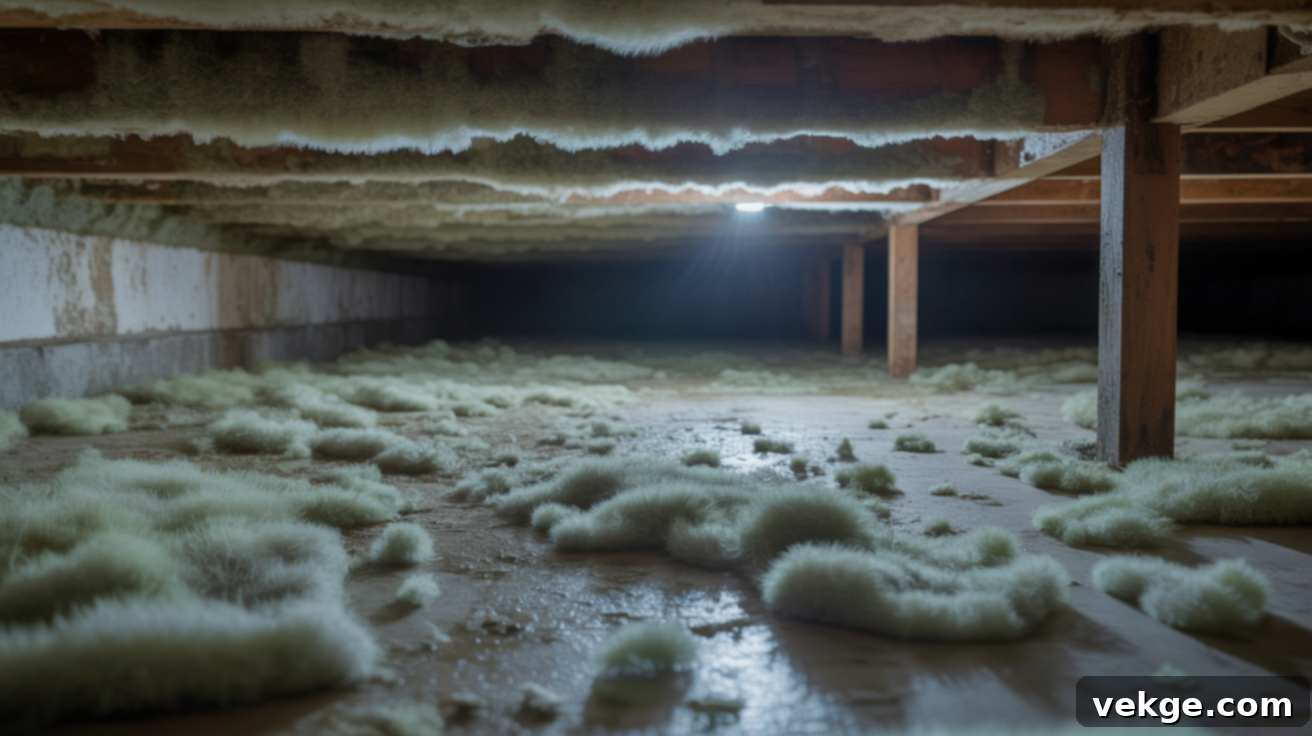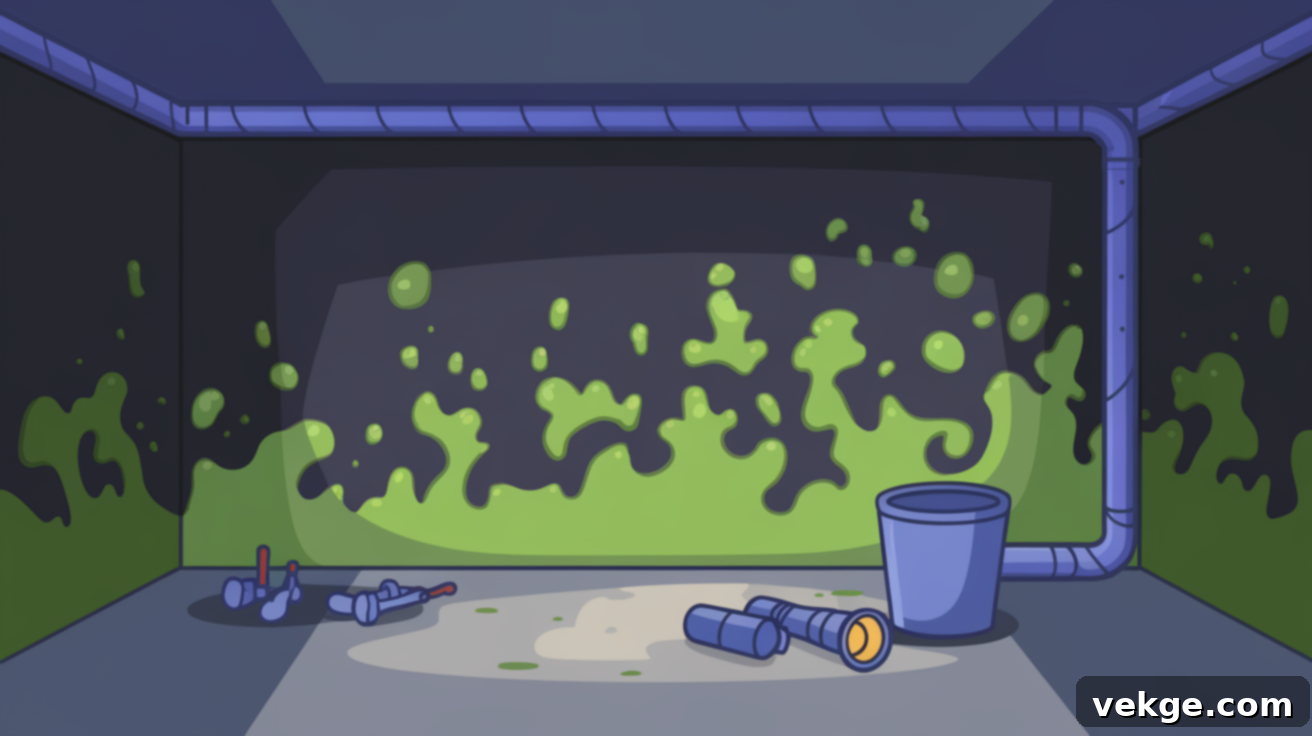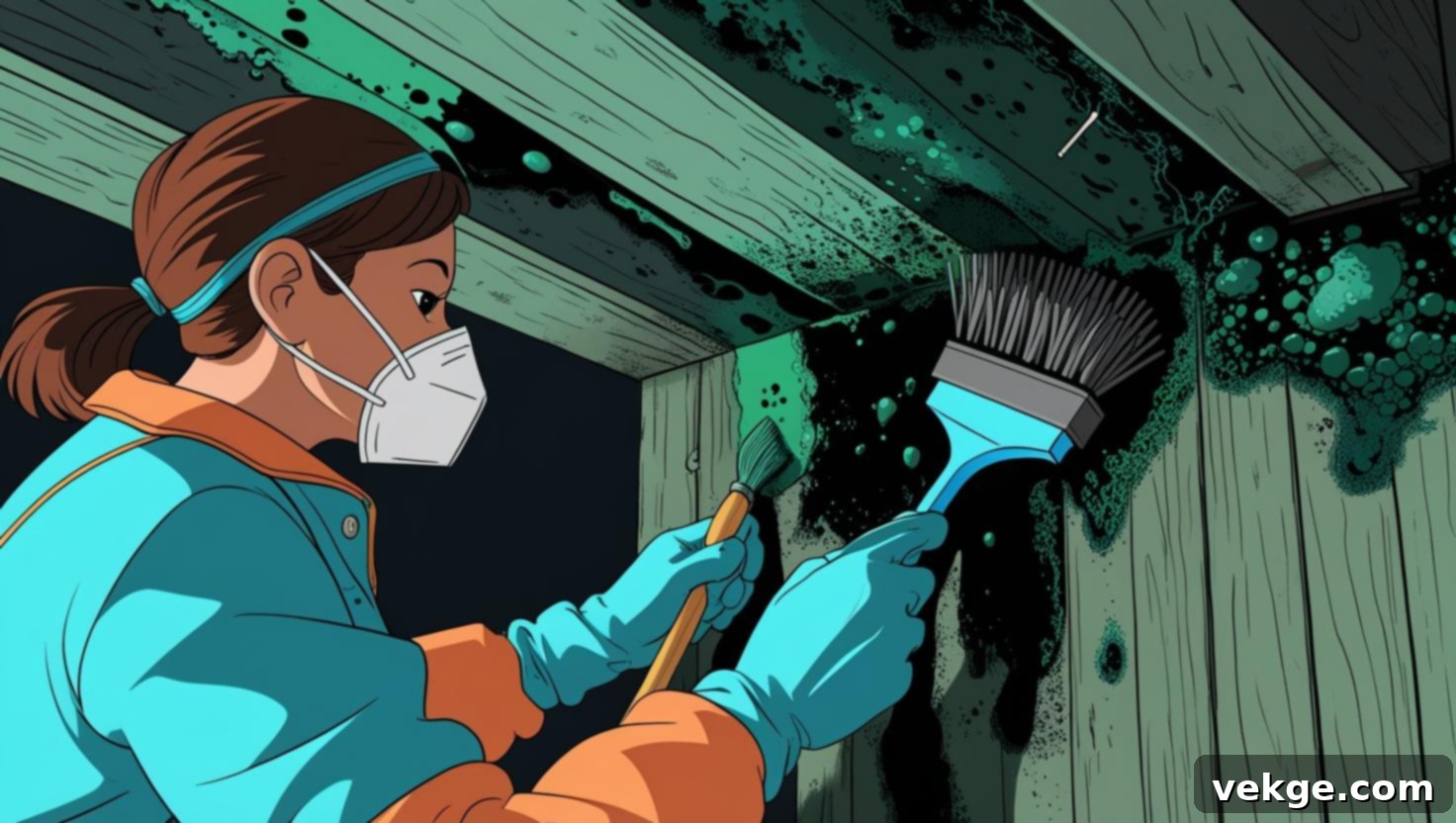Crawl Space Mold: Your Ultimate Guide to Prevention, Removal, and a Healthy Home
If you’ve ever noticed a persistent musty odor, unexplained dampness, or even visible discoloration beneath your home, then mold in the crawl space could be the culprit. This insidious problem doesn’t just create an unpleasant smell; it poses significant risks to both your family’s health and the structural integrity of your home. As someone who has seen the devastating effects firsthand, I can attest that ignoring mold is never an option.
Left unchecked, mold can rapidly spread, releasing spores that trigger a range of health issues from chronic breathing problems and allergies to more severe respiratory infections. Beyond health concerns, it can silently degrade wood, insulation, and other building materials, leading to costly repairs and diminished home value over time. This comprehensive guide will illuminate why mold thrives in crawl spaces, detail the health and structural damage it causes, and, most importantly, provide actionable strategies for effective prevention and removal.
By immersing yourself in this guide, you will gain the critical knowledge needed to identify, address, and permanently eradicate mold in your crawl space, transforming it into a dry, healthy environment. Are you ready to take control and safeguard your home? Let’s get started.
Why Mold Thrives in Crawl Spaces

Crawl spaces are notorious breeding grounds for mold due to a confluence of specific environmental factors. Understanding these primary causes is the first crucial step in preventing a mold infestation from taking root in your home.
- High Humidity: This is arguably the most significant factor. Crawl spaces are frequently characterized by excessively high moisture levels, often exceeding 60% relative humidity. This constant dampness provides the ideal moist environment that mold spores require to germinate and flourish. Sources of this humidity can include ground moisture, plumbing leaks, and even humid outdoor air seeping in.
- Poor Ventilation: A lack of adequate airflow transforms a crawl space into a stagnant, humid chamber. When air cannot circulate freely, moisture becomes trapped, creating pockets of dampness that are perfect for mold colonization. Stagnant air also prevents the drying of wet surfaces, further encouraging mold growth. This trapped, humid air can also rise into your living spaces through the “stack effect,” impacting indoor air quality.
- Water Leaks and Intrusion: Any form of water intrusion—whether from plumbing leaks (such as leaky pipes or faulty connections), foundation cracks allowing groundwater seepage, or even overflowing gutters and poor exterior drainage—introduces direct moisture into the crawl space. Even minor, persistent leaks can saturate building materials, providing mold with a continuous water source it needs to thrive and spread rapidly.
- Condensation: Temperature differentials play a significant role in condensation. When warm, moist air inside the crawl space comes into contact with cooler surfaces (like cold water pipes, HVAC ductwork, or concrete walls), it cools and releases its moisture as liquid water. This condensation often goes unnoticed but can create persistently damp areas, becoming prime targets for mold growth, particularly during seasonal changes.
- Vapor Barrier Issues: A vapor barrier (or moisture barrier) is a critical component designed to block moisture from the soil below from entering the crawl space. If this barrier is damaged, improperly installed, or entirely absent, moisture from the ground will continuously evaporate into the crawl space air. This constant influx of ground moisture significantly elevates humidity levels, providing a steady fuel source for mold to grow on any organic material present.
By proactively addressing these underlying conditions, you can dramatically reduce the likelihood of mold taking hold and developing into a significant problem beneath your home.
Health Risks Associated with Crawl Space Mold
Mold in your crawl space is not merely a structural concern for your property; it poses serious and often underestimated risks to the health of everyone living in your home. The microscopic spores released by mold can become airborne, infiltrating your living areas and triggering a variety of adverse health reactions. As I’ve consistently emphasized, promptly addressing crawl space mold is crucial for safeguarding your family’s well-being.
- Breathing Problems: Exposure to mold spores can irritate the respiratory system, leading to symptoms such as chronic coughing, wheezing, shortness of breath, and nasal congestion. For individuals with existing respiratory conditions, mold can exacerbate these issues. In severe or prolonged cases, it can even contribute to the development of lung infections or inflammation of the airways, making breathing difficult and uncomfortable.
- Allergies and Asthma: Mold is a common allergen, and its spores can trigger significant allergic reactions. Symptoms often include sneezing, runny nose, itchy eyes, skin rashes, and a sore throat. For those already diagnosed with asthma, mold exposure can significantly worsen symptoms, leading to more frequent and severe asthma attacks. Even individuals without a prior history of allergies can develop sensitivities over time with continuous exposure to mold.
- Long-Term Health Issues: Prolonged and significant exposure to mold, particularly certain types, has been linked to more chronic health concerns. These can range from persistent fatigue, headaches, and dizziness to a weakened immune system, making individuals more susceptible to other illnesses. While less common, extreme exposure to certain toxic molds has been associated with neurological symptoms. It is vital not to ignore persistent health issues that seem to improve when you are away from home, as they could be linked to an ongoing mold problem.
Given these potential health ramifications, it is critically important to address any mold in your crawl space swiftly and effectively to protect the health of your entire household.
Identifying Mold in Your Crawl Space

Early detection is paramount in preventing mold from becoming an extensive and costly problem. Knowing how to spot the signs of mold and assess the situation can save you considerable headaches, time, and money down the road. Regular inspections are your first line of defense.
One of the most telling indicators of hidden mold is a persistent musty smell. This distinctive, earthy, or “old basement” odor is often the first clue that mold is present, even before it becomes visible. If this smell permeates your home, particularly in lower levels, it’s a strong signal that mold could be lurking in your crawl space.
Visually, be on the lookout for wet or damp spots on surfaces, as these are ideal conditions for mold growth. Visible mold itself can appear in various forms and colors: it might be fuzzy, slimy, powdery, or cotton-like, and range in color from black, green, and white to grey or brown. Check wood joists, subflooring, insulation, concrete walls, and even stored items for any signs of discoloration or growth.
To conduct a thorough inspection, equip yourself with a powerful flashlight. This will allow you to meticulously examine dark and hidden corners, behind pipes, and along foundation walls where mold frequently thrives out of sight. Pay close attention to areas near plumbing lines or exterior walls that might be prone to moisture intrusion.
A moisture meter can be an invaluable tool for finding hidden dampness. By testing wood or other porous materials, you can pinpoint areas with elevated moisture content, even if no visible water or mold is present. Readings above 15-20% moisture content in wood typically indicate conditions conducive to mold growth and warrant further investigation.
If your inspection reveals a large area of mold (more than 10 square feet), widespread growth, mold on your HVAC system, or if you or your family members are experiencing persistent health issues that you suspect are linked to mold, it is highly advisable to consult with professional mold remediation specialists. They possess the expertise, specialized equipment, and safety protocols to accurately test for mold, identify its source, safely contain and remove it, and implement measures to prevent its recurrence. Attempting to tackle a large infestation yourself can be risky and often ineffective.
Implementing a routine schedule for checking your crawl space will significantly increase your chances of spotting mold early, allowing for timely and effective intervention before it escalates into a more significant and challenging problem.
How to Prevent Mold in Your Crawl Space
Proactive prevention is the most effective strategy against mold in your crawl space, saving you from significant repair costs and potential health issues. From personal experience, I can affirm that the following measures are not only effective but crucial for maintaining a healthy and dry environment beneath your home:
- Improve Ventilation: Good airflow is critical for managing moisture. Start by ensuring that any existing crawl space vents are clear and unobstructed. Consider installing additional vents or, even better, powered exhaust fans to actively pull moist air out of the crawl space and replace it with drier air. Cross-ventilation is key, so strategically place vents or fans to create a consistent air current. This constant movement of air helps moisture evaporate and prevents it from settling on surfaces where mold can thrive.
- Control Humidity: Keeping the relative humidity level in your crawl space below 50% is essential for mold prevention, as mold struggles to grow in drier conditions. A dedicated crawl space dehumidifier is an excellent investment. These units are designed to operate efficiently in cooler, damp environments and can be set to maintain optimal humidity levels automatically. For monitoring, a simple hygrometer can provide accurate readings, allowing you to adjust your dehumidifier settings as needed.
- Install a Robust Vapor Barrier: A high-quality vapor barrier acts as a physical shield against ground moisture. Laying thick (at least 6-mil, preferably 10-20-mil) polyethylene sheeting or a reinforced vapor barrier directly over the soil in your crawl space is fundamental. Ensure the barrier overlaps significantly at seams (at least 6-12 inches) and that all seams are taped securely. For maximum effectiveness, the barrier should also extend up the foundation walls and be sealed to prevent any moisture from the earth from evaporating into the air above.
- Regular Inspections: Consistency is key. Schedule regular inspections of your crawl space – at least twice a year, or even quarterly. During these checks, meticulously look for any signs of water intrusion (leaks, puddles), visible mold growth, condensation on pipes or ductwork, damaged insulation, or issues with your vapor barrier. Catching minor problems early, such as a small leak or a tear in the barrier, makes them infinitely easier and less expensive to fix before they escalate into a major mold infestation.
By diligently implementing these preventive steps, you can create a hostile environment for mold, effectively protecting your home’s structure and ensuring the air quality within your living spaces remains healthy.
DIY vs. Professional Mold Removal
When you discover mold in your crawl space, a critical decision awaits: to undertake the remediation yourself or to enlist the help of a professional. Each approach has its merits, depending on the scope and severity of the mold infestation.
DIY mold removal is generally suitable for small, isolated patches of mold, typically less than 10 square feet. If you’re dealing with surface mold on non-porous materials, you can often clean it yourself. Start by donning essential personal protective equipment (PPE), including an N-95 respirator mask, rubber gloves, and eye protection, to prevent exposure to spores. You can use a mixture of bleach (1 cup per gallon of water) or distilled white vinegar (undiluted) to scrub the affected area thoroughly. For porous materials like wood, borax or hydrogen peroxide solutions can also be effective. After scrubbing, ensure the area is completely dried with fans or dehumidifiers, as any remaining moisture can lead to mold recurrence. Be prepared to repeat the cleaning process if the mold proves stubborn or reappears.
However, if the mold covers a large area, has deeply penetrated porous materials (like insulation or drywall), is linked to an extensive water leak, or if you or your family members are experiencing mold-related health symptoms, then calling in a professional mold remediation expert is highly recommended. Professionals possess specialized tools, training, and knowledge to safely and effectively handle larger, more complex infestations. Their services typically include:
- Comprehensive Assessment: Identifying the species of mold, the extent of the contamination, and the underlying moisture source.
- Containment: Setting up physical barriers and using negative air pressure machines to prevent spores from spreading to other parts of your home during removal.
- Specialized Remediation: Employing industrial-grade cleaning agents, antimicrobial treatments, and air scrubbers with HEPA filters to purify the air.
- Removal of Contaminated Materials: Safely removing and disposing of mold-damaged insulation, wood, or other porous materials that cannot be effectively cleaned.
- Drying and Prevention: Utilizing powerful drying equipment to thoroughly dry the area and implementing solutions like encapsulation or improved ventilation to prevent future growth.
- Post-Remediation Testing: Offering clearance testing to ensure the mold has been successfully removed and the environment is safe.
While DIY mold removal offers a cheaper initial cost, a professional intervention often provides a more lasting and comprehensive solution. The investment in professional expertise can prevent costly structural damage, safeguard your family’s health, and ensure the mold problem is definitively resolved, offering peace of mind that a superficial DIY cleanup might not.
Long-Term Crawl Space Maintenance
Sustaining a dry and well-ventilated crawl space is paramount for preventing mold over the long haul. Based on my experience, incorporating a few ongoing maintenance strategies into your home care routine can effectively keep mold at bay year after year, protecting both your property and your health.
- Install Sump Pumps and Optimize Drainage Solutions: Water accumulation in a crawl space is a mold invitation. A properly installed sump pump is crucial for automatically removing standing water that might enter due to heavy rains or leaks. Beyond the crawl space itself, ensure that your exterior drainage is impeccable. This includes maintaining clean gutters and downspouts that direct water at least 5-10 feet away from your foundation. Additionally, check that the ground around your home slopes away from the foundation (proper grading) to prevent surface water from pooling near or seeping into your crawl space.
- Periodic Mold and Moisture Inspections: Routine vigilance is a game-changer. Make it a habit to inspect your crawl space regularly – ideally at least twice a year, perhaps in spring and fall. During these inspections, meticulously look for any signs of new water intrusion, condensation on pipes or ductwork, damaged or wet insulation, visible mold growth, or pest activity. Document your findings. Early detection of any issues allows for swift corrective action, preventing minor problems from escalating into extensive and expensive mold infestations.
- Consider Crawl Space Encapsulation: For the most robust, long-term mold prevention and moisture control, consider full crawl space encapsulation. This comprehensive solution involves sealing all crawl space vents, installing a heavy-duty vapor barrier that covers the entire floor and extends up the foundation walls, and often insulating the crawl space walls. Once sealed, a dehumidifier or a dedicated supply air duct from your HVAC system can condition the space, maintaining ideal humidity levels (typically below 50%). Encapsulation dramatically reduces moisture entry from the ground and outside air, leading to improved indoor air quality, enhanced energy efficiency for your home, and an effectively mold-free crawl space environment.
These strategic and simple steps collectively contribute to a persistently dry, healthy, and mold-free crawl space, safeguarding your home’s structural integrity and the well-being of its occupants for years to come.
Conclusion
In summary, mold in your crawl space is a serious and potentially destructive issue that demands immediate attention. Its presence poses significant threats, not only to the structural health and longevity of your home but, more critically, to the health and well-being of your family. Understanding the common causes—such as high humidity, poor ventilation, and water intrusion—is the foundational step toward effective mitigation.
By adopting a proactive approach that includes improving ventilation, diligently controlling humidity, installing robust vapor barriers, and conducting regular inspections, you can effectively prevent mold from taking hold and becoming a widespread problem. When mold is detected, discerning between a DIY cleanup and professional remediation is vital for ensuring a complete and lasting solution.
Ultimately, consistent, long-term maintenance, including proper drainage, periodic checks, and considering advanced solutions like crawl space encapsulation, are key to creating a permanently dry, healthy, and mold-free environment beneath your home. By staying ahead of moisture and addressing potential issues promptly, you’ll save valuable time, considerable money, and undue stress in the future, all while protecting your most important investment.
Don’t wait until mold becomes a bigger issue. Take control of your crawl space today and secure a healthier living environment for tomorrow. For more invaluable tips on home maintenance and mold prevention, be sure to explore our other insightful blogs!
